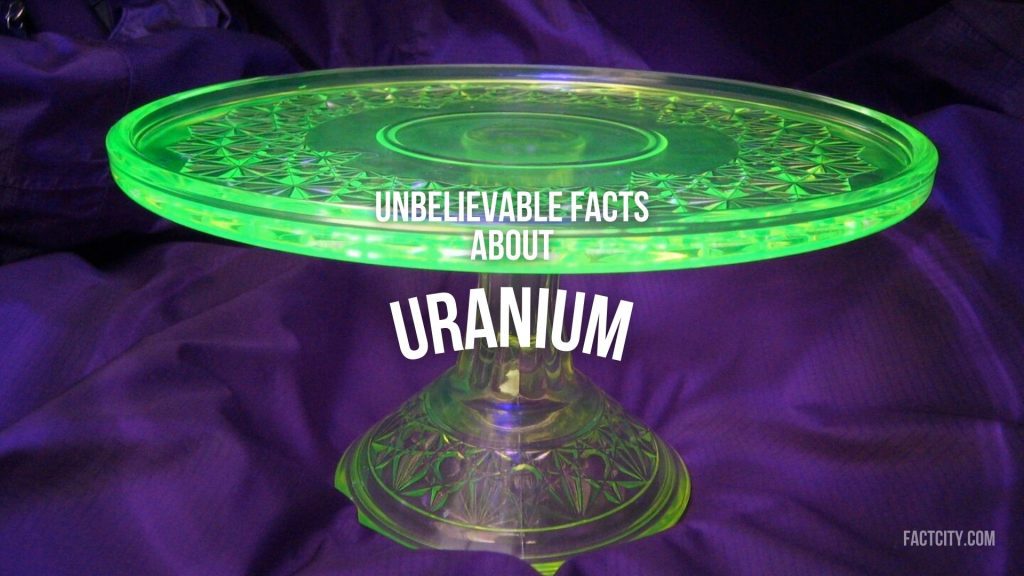Highly useful but just as deadly, uranium is one of the planet’s most interesting elements. You’re probably aware of it most of all thanks to its radioactive properties – but did you know that we can use this strange element to help measure the age of our planet? Whether you’re already a science buff or want to brush up on your periodic table, here are some fun facts about uranium worth remembering.
1. It is represented by “U” on the periodic table.
Uranium is represented by the chemical symbol U. Its atomic number is 92, so look for U 92 on the periodic table!
2. It’s a highly radioactive element.
Uranium’s high levels of radioactivity mean that its nucleus is unstable and can undergo radioactive decay. Technically, it undergoes alpha decay, emitting alpha particles (helium nuclei) as it decays into thorium-234. Hopefully that fills in some of the finer details!
3. It is composed of three isotopes.
Naturally occurring uranium is made up of three isotopes. These include uranium-238 (U-238), uranium-235 (U-235), and uranium-234 (U-234). U-235 is crucial for nuclear reactions because it is fissile, meaning it can easily sustain a nuclear chain reaction.
4. It was discovered in the eighteenth century!
Uranium was discovered in 1789, by famous German chemist Martin Heinrich Klaproth. However, it wasn’t until the mid-19th century that we realised the element was radioactive… whoops!
5. It can help us date the age of the planet!
Believe it or not, uranium can actually help us date the age of the Earth thanks to its own incredible lifespan. Thanks to in-depth research, we now know that U-238 has a very long half-life of about 4.468 billion years!
6. It is found in ore sources.
Uranium can be commonly found in ores like uraninite and pitchblende. Uranium mining is carried out in various countries around the world, with major producers including Kazakhstan, Canada, and Australia.
7. It’s found in some incredible colours.
Uranium compounds can boast incredibly striking colours – for example, uranium glass is green, and uranium hexafluoride is pale yellow!
8. It is an extremely useful fuel for large power generation.
No – you can’t fill up your car with uranium, and that’d be pretty dangerous let alone pointless – but uranium is used as a fuel in nuclear reactors. It is used to produce electricity through nuclear fission.
9. It was used in the atomic bomb.
Specifically, US scientists used Uranium-235 in the “Little Boy” atomic bomb dropped on Hiroshima, Japan, in 1945. The bomb was made all the more deadly thanks to a high concentration of uranium – tragically, it proved to be an effective, but ultimately devastating, weapon asset.
10. Uranium is extremely detrimental to your health.
Uranium and its decay specifically pose serious health risks due to their radioactivity. Prolonged exposure can lead to radiation sickness and an increased risk of cancer. It’s certainly not an element you can be around for long, meaning it’s always wise to leave the handling of uranium to the experts.
11. Uranium waste disposal is a complicated process that requires lots of careful health and safety planning.
The disposal of radioactive waste from uranium mining and nuclear reactors is something of an issue. It specifically poses a significant environmental and safety concern. That is why its disposal must follow strict safety measures and international regulations – otherwise, our lives, and those of plants and animals around the world, would be at serious risk.
FAQs about Uranium
What is uranium used for?
Generally speaking, uranium is mostly used for fuel in nuclear power plants. It is also used in nuclear reactors that can be found in ships and even submarines! It’s an extremely potent element that, when mishandled, proves extremely deadly. Historically, uranium was used in nuclear weapons, too.
Why is uranium so valuable?
Uranium is highly sought-after because it can keep cities and even nations connected to power. It’s a vital power source for nuclear power plants all over the world – meaning it’s unsurprising people pay such high value for it.
Is it safe to touch uranium?
No – unless you’ve had extensive safety training. Since uranium is radioactive and releases radioactive particles that can penetrate the skin and even breathed in, handling uranium carefully is a must. Mishandling it can lead to a list of health issues for the handler, and could potentially expose others to its toxicity.
Further reading:
https://www.iaea.org/newscentre/news/what-is-uranium
https://world-nuclear.org/information-library/nuclear-fuel-cycle/introduction/what-is-uranium-how-does-it-work.aspx
Do you know any interesting facts about Uranium? Share them in the comments below!
